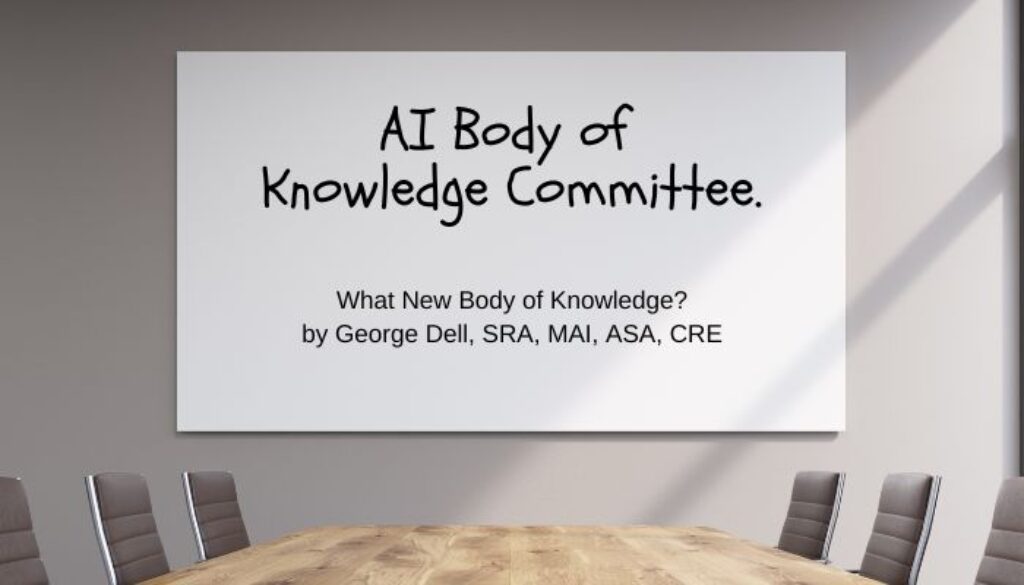A Body of Knowledge committee?
I was just getting acquainted with the Appraisal Institute service structure. At one of the first of many times at AI national or Board meetings, it seemed a good idea to find a committee focused on where I might be able to genuinely contribute.
Upon noticing there was a Body of Knowledge committee, I jumped on it. I could contribute! I knew that the computer world, the data world, and even economic theory had had important growth and change. Perfect. I had completed, while an appraiser, several years of study in statistics, econometrics, and even risk mathematics at graduate levels. Each class led me to be encouraged (or bothered) by its applicability to actual, practical appraisal work (including AVMs).
I tracked down the committee meeting room and arrived, hoping I would be allowed to sit in on the exciting meeting leading the future of valuation, competing with upstart AVMs. Wrong.
The room was empty.
The committee did not show up. Nothing new. Nothing to do. It had all been figured out.
In part one of this series, we noted that appraisal “methods and techniques” were established nearly 100 years ago. There were a few changes after the “three approaches” – like discounted cash flow and “support” for adjustments. Scope of work became a thing, and market analysis in the form of the R-41 income approach series of regulatory requirements, prior to ‘official’ USPAP. But not much else. We were still using old methods and techniques; typewriters and copy machines, and hand calculators.
Then we got new models and algorithms; computers, instant data, and analytic/statistical software.
But Data Science was not a thing yet. We started to get computer power. Then that science said we need more (or less) clever “statistics.” We need expert judgment, and the visual connection between the human brain and the computer.
Appraisal, and valuation of all kinds, involve the same thing, the same process: 1) subject and assumptions; 2) data selection; 3) adjustments or predictives, and; 4) communication/explanation.
We came to call valuation data science “Evidence Based Valuation” (EBV)©.
Subject matter information and scope became more defined, numbers more than words. Data collection shifted from picking some comps to “identify the market.” We call it the CMS©. (Competitive Market Segment). Opinion/results went from “adjustments” to predictive practice. And word reconciliation went to reliability/risk indications.
The subject matter focused more on the micro-economics, not “procedures.” Not the “equilibrium” economics – (of many buyers and sellers, homogeneous product, good knowledge, and free participation). But the reality of small unique property markets – requiring “game theory.”
The analytics became really possible for the first time. Software beyond rectangular spreadsheets and rectangular forms. Software designed from the ground up for analytics. Measuring markets. And visuals: graphs, maps, tables, using complete and relevant data.
The technology: the data, the computation, the visualization had changed, but not the body of knowledge. Little did I guess that 25 years later, I would be singing the same tired song.
And today it is possible, but not yet demanded, to produce reproducible appraisals. Reproducibility is the hallmark of the scientific method. Use data, analytics, and clear, distinct judgment calls.
The Appraisal Institute must take the lead. No other prevailing organization is in a position to do this.

September 4, 2024 @ 8:40 am
I have known George Dell for 40-years and continue to learn something new about him. I wonder what the Body of Knowledge Committee is doing these days, or is there one?
September 9, 2024 @ 7:57 am
George, I do believe we are at a tipping point. You have pounded the drum for years for appraisers to take the bull by the horns but the tools for appraisers to use required additional effort to learn and the investment by and on behalf of the masses (those that do lender work, which are the vast majority) investment in advanced technologies and supportive methodologies was supressed by those who set the bar.
The lack of accountability has exposed flaws in the system or rather the system is now being exposed.
Representatives of the public are now asking the right questions and what they are asking for is credibility, and accountability. They are asking for evidence to support conclusions.
Appraisers who take the next steps to produce those kinds of analysis and reports will be at the leading edge. Combine that with advancements that actually make the technology easier to use, learn and understand is the key ingredient that will tip the scales.